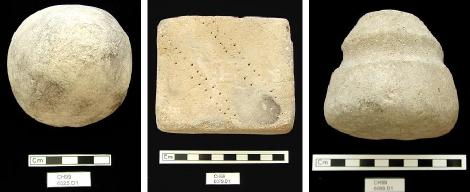Clay Balls and Objects
Sonya AtalayDuring the 2000 study season the majority of time was devoted to analysis of the unstudied clay balls and objects from previous seasons. Various analyses, including organic residue analysis, petrography of both artifactual samples and experimental pieces, are in progress.
However, some patterns, which began to emerge during previous field seasons are now more clear after this seasons work: 1) Non-spherical clay objects do not only occur in the early trench of the South Area or the off site KOPAL Area, but are also found in small amounts in many contexts and units in the later South area levels (in the material studied so far no objects come from the North or BACH1 areas). 2) The difference in fabric, first noted last season while examining some of the South and Kopal materials, (i.e. larger fragments of mineral inclusions from a wider variety of mineral sources) seems to be related to time older (earlier) balls and objects tend to have larger inclusions while balls from more recent (later) units have a more fine even paste. 3) There is clearly a limited range of geometric shapes which Neolithic peoples chose for these objects (spherical, conical, cubical, ovaloid). There is some variety in the details of the objects, but they all generally conform to these basic shapes. 4) The decoration or elaboration of these balls and objects (mostly incised lines, dots or basket/matting impressions) is rare and occurs on only 5% of the material studied so far.
Interpretation so far is that a change in production/technology occurred slowly at Çatalhöyük during which time people began to make more spheres and less objects in other geometric shapes and all with a finer mineral based temper. Reasons may have been as varied as personal preferences, better performance, change in ritual, change in use, different producers, change of supply of raw materials. All of these are certainly possible as well as a myriad of other explanations or interpretations. Why were some balls and objects decorated? Did it reflect ownership, or special ritual use, or was it even intentional as in the case of basket and matting impressions.

Figure 19: A selection of clay onjects found in the KOPAL area in 1999, illustrating the variation in shape (reproduced from Çatal News 6)